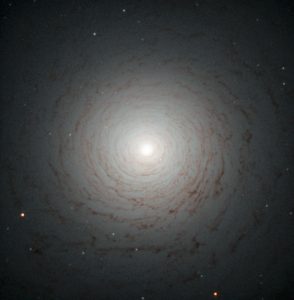Una misteriosa antica spirale
Questa spettrale immagine ripresa dal telescopio Hubble rivela l’impressionante centro della galassia NGC 524. È una galassia di tipo lenticolare, uno stadio intermedio nell’evoluzione galattica tra le ellittiche e le galassie a spirale; si trova nella costellazione dei Pesci, a circa 90 milioni di anni luce dalla Terra.
Le spirali sono galassie di mezza età con vasti bracci contenenti milioni di stelle. Insieme a questi astri sono presenti grandi nubi di gas e polveri che, nel caso siano abbastanza dense, possono essere luoghi dove nascono nuove stelle. Quando tutto il gas è esaurito o disperso nello spazio, i bracci a poco a poco svaniscono e la forma a spirale comincia ad attenuarsi.
Al termine di questo processo, l’oggetto che rimane è una galassia lenticolare, un disco luminoso pieno di vecchie stelle rosse circondate da quel poco di gas e polveri a cui la galassia è riuscita ad aggrapparsi.
L’immagine mostra la struttura di NGC 524 in dettaglio, formata dal gas residuo che circonda il bulge centrale. Le osservazioni di questa galassia hanno rivelato che conserva un qualche moto a spirale, il che può spiegare la sua complessa struttura.
[ Barbara Bubbi ]
https://www.spacetelescope.org/images/potw1329a/
Credit: ESA/Hubble & NASA

Lascia un commento